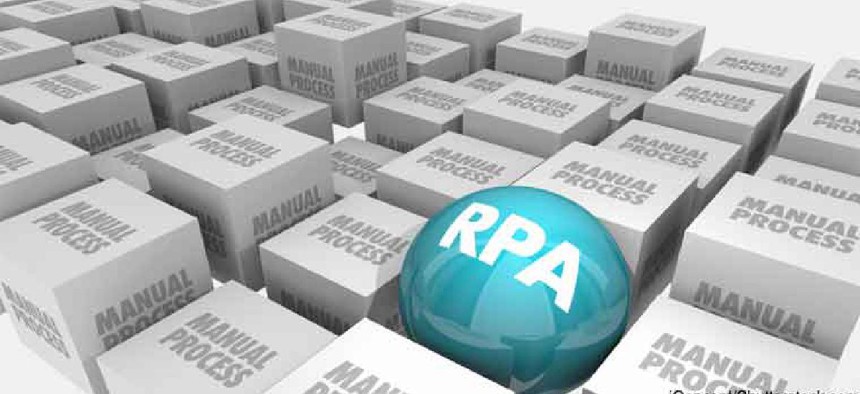RPA turns modernization goals into reality

Robotic process automation will eventually become a part of the core technology platform stack for agency business applications.
As we look down the road, many promising technologies are finding greater use across the federal government. In my opinion, no technology holds more promise in the immediate future than intelligent automation using robotic process automation (RPA).
RPA will continue to grow as a valuable tool for government IT leaders because it allows the immediate expansion and scaling of human labor without impacting existing systems. Whenever agencies try to automate tasks, there is often a significant development effort. With RPA, an agency can implement and test on a small scale and then quickly expand to automate additional manual tasks.
While the technology has widespread use across many sectors, RPA is uniquely positioned to help government agencies maintain and deliver quality service while ensuring that valuable human resources can focus on high-value tasks. Think about it this way: Any mundane operation that does not require subjectivity of humans can be a potential candidate for the RPA technology.
Once agencies are able to identify the specific operations that can be automated based on their business objectives, they can maximize the effort of employees by allowing bots to take care of their mundane tasks.
With a new presidential administration, IT modernization will likely remain a top priority for agencies, and RPA can help them turn goals into reality.
Implementing RPA
Getting started with RPA is simple, and agencies can quickly see results. Some considerations for implementation:
- After identifying the processes that make the most sense for automation, agencies should ensure that the RPA technology they select is easy to use and implement.
- To get the most out of RPA, security must be addressed at the architecture level and comply with agency requirements.
- Reliability engenders confidence that the platform can automate mundane tasks safely without causing any disruption. The ability to onboard and scale automation across an organization is key to success.
- Understanding the capabilities of the RPA technology and how it interacts with enterprise systems is key. If an agency cannot leverage most of the platform’s features, then essentially, the comprehensive value of the RPA is not realized. Most RPA platforms are mature enough to interface with enterprise systems, but it’s still important to ensure that an RPA integrates and automates the desired processes properly.
Quantifying the success is easy
One of the reasons I am so bullish on RPA is how easy it is to quantify the results and show its value. The standard approach followed in the industry is to quantify the time and effort translated to costs spent on completing a task currently and then to evaluate the cost-avoidance savings after the RPA implementation. For agencies looking to improve performance while confirming savings, RPA is perfect.
In one government agency, for example, the workforce management specialists would receive roughly 1,700 schedule adjustments per day and manually update the changes. After implementing an RPA bot, the agency was able to achieve 94% automation on those tasks. This implementation not only made a difference to the bottom line, but also freed up precious staff to address more complex tasks.
The promising future of RPA
The best functions for initially deploying RPA technology have been in finance and procurement, human resources and operations, which typically feature many manual, repetitive tasks. By quickly deploying RPA, agencies can evaluate the benefits and outcomes, and then identify other functions that could similarly benefit. There typically isn’t a large or lengthy timeframe required for the initial implementation; however, once established it is imperative that the agency continue to identify and automate suitable processes.
I believe RPA will eventually become a part of the core technology platform stack for business applications that both directly address agency missions and their supporting functions. RPA will become an embedded component in standard solutions, and we’ll start to see that evolution beginning in earnest as soon as this year.
As agencies continue to adopt RPA, the benefits in efficiency will be too great to ignore. I expect that RPA will quickly become a ubiquitous tool for government IT leaders effectively enhancing delivery of mission objectives.





